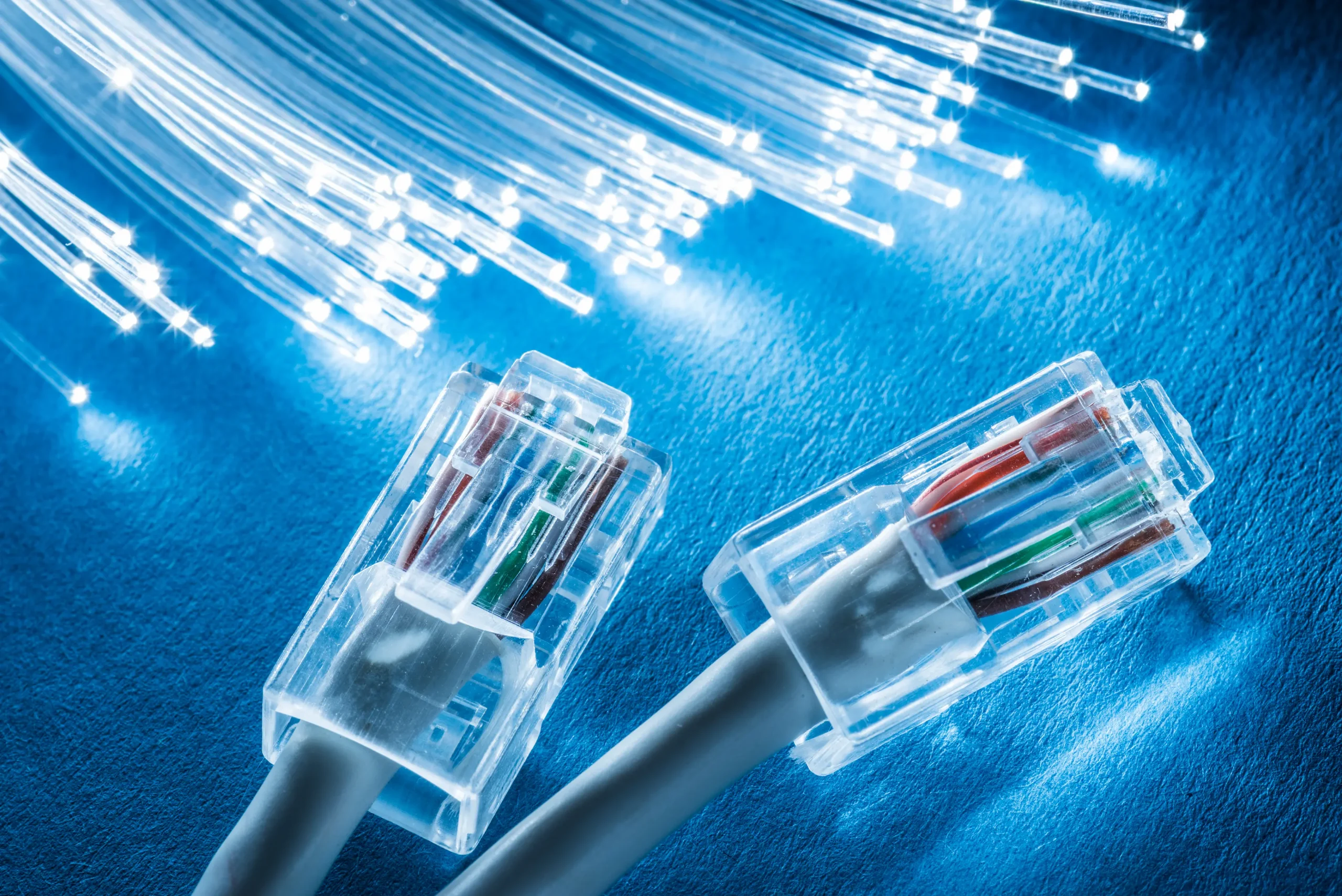Fiber optic technology has revolutionized the world of communications, providing a robust and efficient infrastructure for data transmission over long distances. Let’s explore the fascinating world of fiber optics, exploring its different types and the various characteristics that make them unique. From multimode to single-mode fiber, each
Single-mode fiber: boosting connectivity over long distances
Multimode optical fiber plays a crucial role in local and enterprise network infrastructure. Its design allows transmission of multiple light modes simultaneously, making it ideal for short distances and applications where transmission speed and connectivity are priorities. Multimode optical fiber is known for its lower initial cost and ease of installation, making it an attractive option for environments where rapid network deployment is required.
Multimode optical fiber provides flexibility and versatility in environments where distances are relatively short and signal dispersion is not a significant concern. In enterprise environments and data centers, where fast and reliable connectivity is essential, multimode optical fiber is a popular choice. Its ability to support transmission distances of up to several hundred meters makes it a viable option for local area networks (LANs) and other short-distance applications.
On the other hand, single-mode optical fiber excels in applications requiring long distance transmissions with minimal signal loss. Its design allows only one light mode to pass through the fiber, which reduces signal dispersion and attenuation, enabling transmission distances of several kilometers to be achieved without significant degradation.
In addition to its impressive reach, single-mode optical fiber also excels in its ability to support a wide range of light frequencies, making it ideal for applications requiring exceptionally high bandwidth. This is especially relevant in the context of high-speed data networks and next-generation communications, where the demand for bandwidth continues to grow exponentially.
Characteristics of Singlemode Fiber:
Transmission distance:
The main distinguishing feature of single-mode fiber is its ability to transmit data over extremely long distances without crucial signal degradation. This is due to the low dispersion and attenuation of light in the fiber core, which allows distances of up to several kilometers to be reached without the need for repeaters or signal amplifiers.
Transmission speed:
Single-mode fiber can support extremely high transmission speeds, making it ideal for applications requiring very high bandwidth and minimal latency. This makes it the preferred choice for high-speed, high-capacity networks such as wide area networks (WANs) and fiber-to-the-home (FTTH) connections.
Lower signal attenuation:
Due to its single core design and reduced diameter, single-mode fiber experiences less signal attenuation compared to multimode fiber. This means that data can travel longer distances without loss of intensity, resulting in more reliable transmission and fewer data errors.
Single-mode fiber applications:
Single-mode fiber is used in a wide range of applications requiring long distance transmissions and high speeds, including:
Wide Area Networks (WANs): connecting geographically dispersed locations, rely heavily on single-mode fiber to provide reliable, high-speed connectivity over long distances.
Fiber-to-the-home (FTTH) connections:Single-mode fiber is the preferred choice for providing fiber optic connections directly to homes and buildings, as it enables fast and reliable data transmission over long distances.
Long-distance telecommunications: Telecommunications networks that require voice, data and video transmissions over extremely long distances rely on single-mode fiber to ensure reliable, high-speed connectivity.
Advantages of Singlemode Fiber:
- Longer transmission distance: Single-mode fiber can transmit data over much greater distances than multimode fiber, making it ideal for long-distance applications.
- Higher transmission speeds: Single-mode fiber can support extremely high transmission speeds, making it the preferred choice for high-speed, high-capacity networks.
- Lower signal attenuation: Due to its single-core design and reduced diameter, single-mode fiber experiences less signal attenuation compared to multimode fiber, resulting in more reliable transmission and fewer data errors.
Multimode Fiber: the versatility in fiber optic networks
In the telecommunications universe, where speed and efficiency are critical, optical fiber has become the undisputed leader in data transmission. Among the available options, multimode fiber stands out for its versatility and ability to adapt to various applications in enterprise and data center environments.
Multimode optical fiber plays a crucial role in local and enterprise network infrastructure. Its design allows transmission of multiple light modes simultaneously, making it ideal for short distances and applications where transmission speed and connectivity are priorities. Multimode optical fiber is known for its lower initial cost and ease of installation, making it an attractive option for environments where rapid network deployment is required.
Multimode optical fiber provides flexibility and versatility in environments where distances are relatively short and signal dispersion is not a significant concern. In enterprise environments and data centers, where fast and reliable connectivity is essential, multimode optical fiber is a popular choice. Its ability to support transmission distances of up to several hundred meters makes it a viable option for local area networks (LANs) and other short-distance applications.
What is Multimode Fiber?
Multimode fiber is a variant of fiber optic technology that allows multiple modes of light to travel through it simultaneously. This is achieved thanks to a larger fiber core compared to single-mode fiber, which facilitates the propagation of light in different paths. This feature makes it suitable for shorter distances and applications where transmission speed is not as critical as in long distance networks.

Characteristics of Multimode Fiber:
- Larger core diameter: Multimode fiber has a larger core compared to single-mode fiber, which allows multiple light modes to pass simultaneously in the fiber optic network.
- Lower installation cost: Due to its less complex design, multimode fiber tends to be less expensive in terms of installation and maintenance compared to single-mode fiber, making it an attractive option in the deployment of fiber optic networks.
- Application flexibility: Multimode fiber is ideal for a variety of applications in enterprise and data center environments, where transmission distances are relatively short and transmission speed can vary, making it a versatile choice in fiber optic networks.
Advantages of Multimode Fiber:
- Lower initial cost: Multimode fiber is typically less expensive than single-mode fiber, making it attractive to organizations with limited budgets in deploying fiber optic infrastructure.
- Easy installation and maintenance: Due to its simpler design, multimode fiber is easier to install and maintain, which can reduce long-term operating costs in fiber optic networks.
- Suitable for short distancesMultimode fiber is ideal for applications requiring shorter transmission distances, such as connections within a building or between nearby buildings, making it a practical choice in environments where optical fiber is deployed.
Multimode Fiber Applications:
-
Local Area Networks (LAN): Multimode fiber is commonly used in local area networks (LANs) within enterprise environments, where fast and reliable connectivity between devices over optical fiber is required.
-
Data centers: In data center environments, where connectivity between servers and storage devices is critical, multimode fiber can provide a cost-effective and efficient solution in fiber optic networks.
-
Video and audio applications: Multimode fiber is also used in video and audio applications, where fast and reliable data transmission is required, such as in conference systems and control rooms, taking advantage of the capabilities of fiber optic networks.
Multimode fiber continues to be a leading choice in the deployment of fiber optic networks due to its versatility, cost-effectiveness and ease of implementation.
From the ability of multimode fiber to provide fast connectivity over short distances to the exceptional transmission length of single-mode fiber, each type of optical fiber has unique characteristics that make it suitable for a wide variety of scenarios.
Fiber optic capacity offers ultra-fast transmission speeds, minimal latency and exceptional reliability, making it the preferred choice for a wide range of applications, from telecommunications to Internet infrastructure.
In an increasingly interconnected future, fiber optics will continue to be a fundamental technology that drives progress and innovation in communications. Fiber optics will continue to be the preferred medium for data transmission in the digital age.



